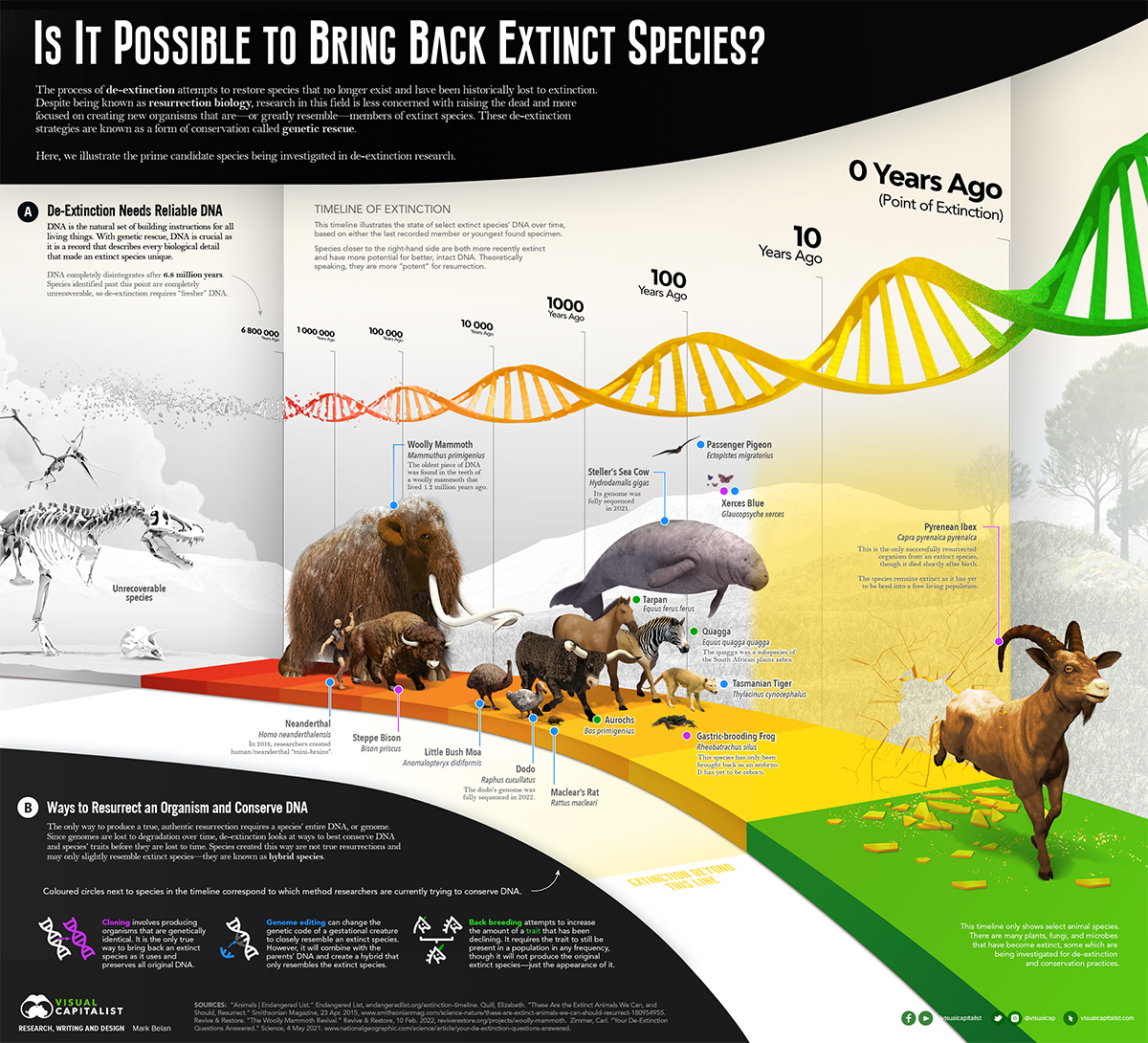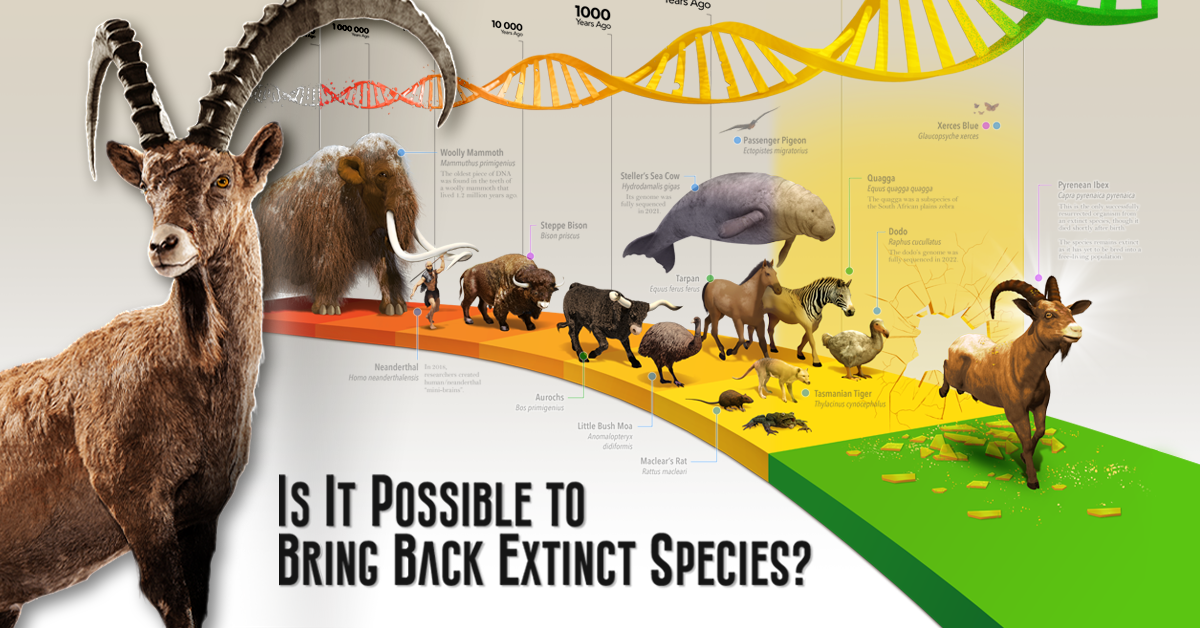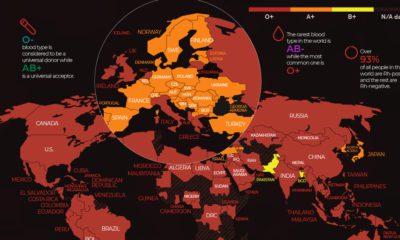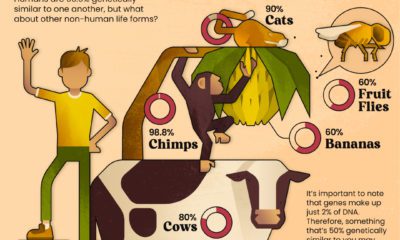Misc
Is it Possible to Bring Back Extinct Animal Species?
View a higher resolution version of this infographic.
Is it Possible to Bring Back Extinct Animal Species?
View a higher resolution version of this infographic.
Humanity has been tinkering with natural life for thousands of years.
We’ve become remarkably good at it, too—to date, we’ve modified bacteria to produce drugs, created crops with built-in pesticides, and even made a glow-in-the-dark dog.
However, despite our many achievements in the realm of genetic engineering, one thing we’re still working on is bringing extinct animals back to life.
But scientists are working on it. In fact, there’s a whole field of biology that’s focused on reviving extinct species.
This graphic provides a brief introduction to the fascinating field of science known as resurrection biology—or de-extinction.
The Benefits of De-Extinction
First thing’s first—what is the point of bringing back extinct animals?
There are a number of research benefits that come with de-extinction. For instance, some scientists believe studying previously extinct animals and looking at how they function could help fill some gaps in our current theories around evolution.
De-extinction could also have a beneficial impact on the environment. That’s because when an animal goes extinct, its absence has a ripple effect on all the flora and fauna involved in that animal’s food web.
Because of this, reintroducing previously extinct species back into their old ecosystems could help rebalance and restore off-kilter environments.
There’s even a possibility that de-extinction could slow down global warming. Scientist Sergey Zimov believes that, if we were to reintroduce an animal that’s similar to the woolly mammoth back to the tundra, it could help repopulate the area, regrow ancient plains, and possibly slow the melting of the ice caps.
How Does it Work?
The key element that’s needed to re-create a species is its DNA.
Unfortunately, DNA slowly degrades, and once it’s gone completely, there’s no way to recover it. Researchers believe DNA has a half-life of 521 years, so after 6.8 million years, it’s believed to be completely gone.
That’s why species like dinosaurs have virtually no chance of de-extinction. However, many organisms that went extinct more recently, like the dodo, could have a chance of conservation.
When it comes to de-extinction, there are three main techniques:
① Cloning
This is the only way to create an exact DNA replica of something.
However, a complete genome is needed for this, so this form of genetic rescue is most effective with recently-lost species, or species that are nearing extinction.
② Genome Editing
Genome editing is the manipulation of DNA to mimic extinct DNA.
There are several ways to do this, but in general, the process involves researchers manipulating the genomes of living species to make a new species that closely resembles an extinct one.
Because it’s not an exact copy of the extinct species’ DNA, this method will create a hybrid species that only resembles the extinct animal.
③ Back-Breeding
A form of breeding where a distinguishing trait from an extinct species (a horn or a color pattern) is bred back into living populations.
This requires the trait to still exist in some frequency in similar species, and the trait is selectively bred back into popularity.
Like genome editing, this method does not resurrect an extinct species, but resurrects the DNA and genetic diversity that gave the extinct species a distinguishing trait.
Is Bringing Back Extinct Animal Species Really Worth it?
While there’s a ton of buzz and potential around the idea of bringing back extinct animal species, there are a few critics that believe our efforts would be better spent on other things.
Research on the economics of de-extinction found that the money would go farther if it was invested into conservation programs for living species—approximately two to eight times more species could be saved if invested in existing conversation programs.
In an article in Science, Joseph Bennett, a biologist at Carleton University in Ottawa, said “if [a] billionaire is only interested in bringing back a species from the dead, power to him or her.”
Bennett added, “however, if that billionaire is couching it in terms of it being a biodiversity conservation, then that’s disingenuous. There are plenty of species out there on the verge of extinction now that could be saved with the same resources.”
China
How Do Chinese Citizens Feel About Other Countries?
What is the Chinese public’s view of world powers? This visual breaks down Chinese sentiment towards other countries.
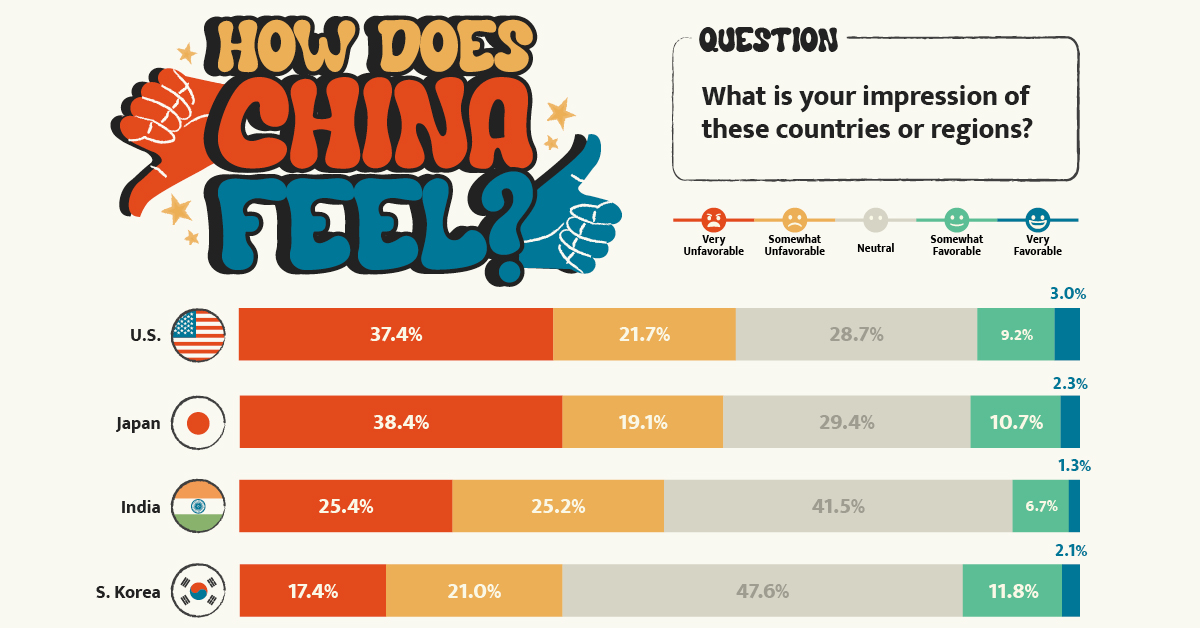
Public Opinion: How Chinese Citizens Feel About Other Countries
Tensions over Taiwan, the COVID-19 pandemic, trade, and the war in Ukraine have impacted Chinese sentiment towards other countries.
This visualization uses data from the Center for International Security and Strategy (CISS) at Tsinghua University to rank survey responses from the Chinese public on their attitudes towards countries and regions around the world.
Chinese Sentiment Towards Other Countries in 2023
In the Center’s opinion polls, which surveyed a random sample of more than 2,500 Chinese mainland adults in November 2022, Russia came out significantly ahead.
Just under 60% of respondents held Russia in a favorable view, with 19% seeing the country as “very favorable.” Contrast that to the mere 12% that viewed the U.S. in a positive light.
Here’s a closer look at the data. The percentages refer to the share of respondents that voted for said category.
| Country/Region | Very Unfavorable | Somewhat Unfavorable | Neutral | Somewhat Favorable | Very Favorable |
|---|---|---|---|---|---|
| 🇺🇸 United States | 37.4% | 21.7% | 28.7% | 9.2% | 3.0% |
| 🇯🇵 Japan | 38.4% | 19.1% | 29.4% | 10.7% | 2.3% |
| 🇮🇳 India | 25.4% | 25.2% | 41.5% | 6.7% | 1.3% |
| 🇰🇷 South Korea | 17.4% | 21.0% | 47.6% | 11.8% | 2.1% |
| 🇪🇺 European Union | 9.3% | 15.6% | 57.6% | 14.1% | 3.3% |
| Southeast Asia | 7.1% | 13.1% | 59.5% | 16.8% | 3.5% |
| 🇷🇺 Russia | 3.0% | 4.8% | 33.7% | 39.4% | 19.0% |
Japan ranked just below the U.S. in terms of overall unfavorability, though a slightly higher share of respondents saw Japan as “very unfavorable” compared to America. This is likely due to both modern tensions in the East China Sea over mutually claimed islands and historical tensions over the Sino-Japanese Wars.
Chinese sentiment towards India was also unfavorable at just over 50%, though notably the country also received the lowest favorability rating at just 8%.
Additional Survey Findings
The survey also found that 39% of Chinese people get their information on international security from Chinese state-run media (mainly through TV), with an additional 19% getting information from government websites and official social accounts. Conversely, only 1.7% get their news from foreign websites and foreign social media, partially due to the Great Firewall.
When asked about different international security issues, the biggest shares of Chinese citizens ranked the following as their top three:
- Pandemics (12.9%)
- Disputes over territory and territorial waters (12.9%)
- China-U.S. relations (12.0%)
The pandemic’s high score reflects the harsher impact COVID-19 had on China. Chinese borders were shut for years and the public faced intense measures to reduce spread.
In terms of other world events, the majority of Chinese people align with a more “Eastern” viewpoint. For example, in regards to the war in Ukraine, the report found that:
“About 80 percent of the respondents believe the U.S. and Western countries should be held most accountable [for the war], while less than ten percent of the respondents argue that Russia is mainly responsible.”– Center for International Security and Strategy, Tsinghua University
Overall, the views of the Chinese public reflect the opposite of those found in many Western countries. They provide an important insight that it is not just the Chinese government holding particular views about the world, but the Chinese public as well.
-

 Markets4 weeks ago
Markets4 weeks agoThe World’s Biggest Mutual Fund and ETF Providers
-

 Markets2 weeks ago
Markets2 weeks agoBrand Reputations: Ranking the Best and Worst in 2023
-

 Environment5 days ago
Environment5 days agoHotter Than Ever: 2023 Sets New Global Temperature Records
-

 Datastream4 weeks ago
Datastream4 weeks agoCan You Calculate Your Daily Carbon Footprint?
-

 Energy2 weeks ago
Energy2 weeks agoWho’s Still Buying Russian Fossil Fuels in 2023?
-

 VC+5 days ago
VC+5 days agoWhat’s New on VC+ in July
-

 Investor Education4 weeks ago
Investor Education4 weeks agoVisualizing BlackRock’s Top Equity Holdings
-

 apps2 weeks ago
apps2 weeks agoMeet the Competing Apps Battling for Twitter’s Market Share

